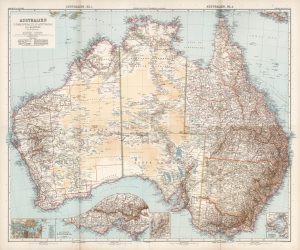The COVID-19 pandemic has not only affected millions of individual lives, it has also undermined long-held economic ideas, as well as potentially having a long-term effect on regional and global balances of power. Yet in Australia there has also been a noticeable shift in the internal balance of power, with the reemergence of the country’s states as powerful players in relation to the federal government. This may precipitate a permanent reconfiguration of how the country operates.
In the early decades of its federation, Australia’s states were the country’s dominant political actors. Without a distinct national capital until 1927, and with the actual role of the prime minister lacking articulation, the premiers of New South Wales and Victoria were Australia’s most powerful political figures.
It was only after the federal government seized full control of income tax collection during World War II — stripping the states of much of their financial independence — that Canberra started to fully emerge as the true center of power in the country. Since then, there has been a steady bleeding of powers from the states to the federal government.
Until the pandemic, Australians have mostly been fine with this. Unlike its close political cousin in Canada — where regional identities are far stronger than national identity — loss of power to the federal government has not been deemed a personal affront or an existential threat. As long as general good governance was maintained, Australians haven’t minded who was doing the governing.
But the pandemic directly affected one major area in which states have maintained primary responsibility: public health. States began to see other Australians traveling across their borders as a significant threat to their local healthcare systems. As a result, the country’s internal borders, in an extraordinary decision, were closed.
Having the coercive powers of their own police forces — and advantaged by the limited number of roads that cross state boundaries — made implementing closures relatively easy. For those who lived in one state but worked in another, an internal visa system was created. Although Section 92 of the Australian Constitution asserts that “trade commerce and intercourse… shall be absolutely free,” the states simply chose to ignore the provision amid the pandemic crisis.
The federal government briefly joined a legal action against Western Australia (WA) that would force it to open its borders, but then abruptly withdrew its support. The states had stared down both the federal government and the constitution. There was a noticeable shift in power in the country: Premiers looked strong, and the prime minister looked weak. In a demonstration of this strength, the two state elections that were held during the pandemic — in Queensland and WA — produced comfortable victories for the incumbent governments. In WA, where Premier Mark McGowan played the game of internal isolation the hardest, the victory was crushing, with the incumbent party winning 53 of the state legislature’s 59 seats.
The reemergence of state power also came through the federal government’s own initiative, by reorganizing the way regional leaders interact with Canberra. Previously, the Council of Australian Governments (COAG) — consisting of the prime minister, the six state premiers, and two territory chief ministers — met only twice a year to discuss matters of the federation. However, as the impact of the pandemic required greater coordination between the two levels of government, a new and far more regular body known as the National Cabinet was created, holding meetings as often as twice a week during periods of high intensity work.
This has significantly increased the power of the states in the country’s decision-making process. It has provided savvy and persuasive premiers with the ability to regularly sway the federal government’s actions in their favor. The plan now is to make the body a permanent fixture in the country’s governance system, with monthly meetings scheduled to be held once normalcy has returned. Institutionalizing this new cooperative structure has the potential to work in the states’ favor.
The pandemic has obviously made a certain level of isolation a necessity, but Australia is unique among similarly organized countries in that it quickly unwound the ideals of the federation as a defense mechanism. But this isolation has also delivered a renewed sense of local power that Australia’s states had previously been nonchalant about. And they may not be willing to relinquish that power once the pandemic has subsided. With the country’s economic — and cultural — power concentrated in Sydney and Melbourne, the premiers of New South Wales and Victoria could once again become Australia’s most powerful political actors.

































